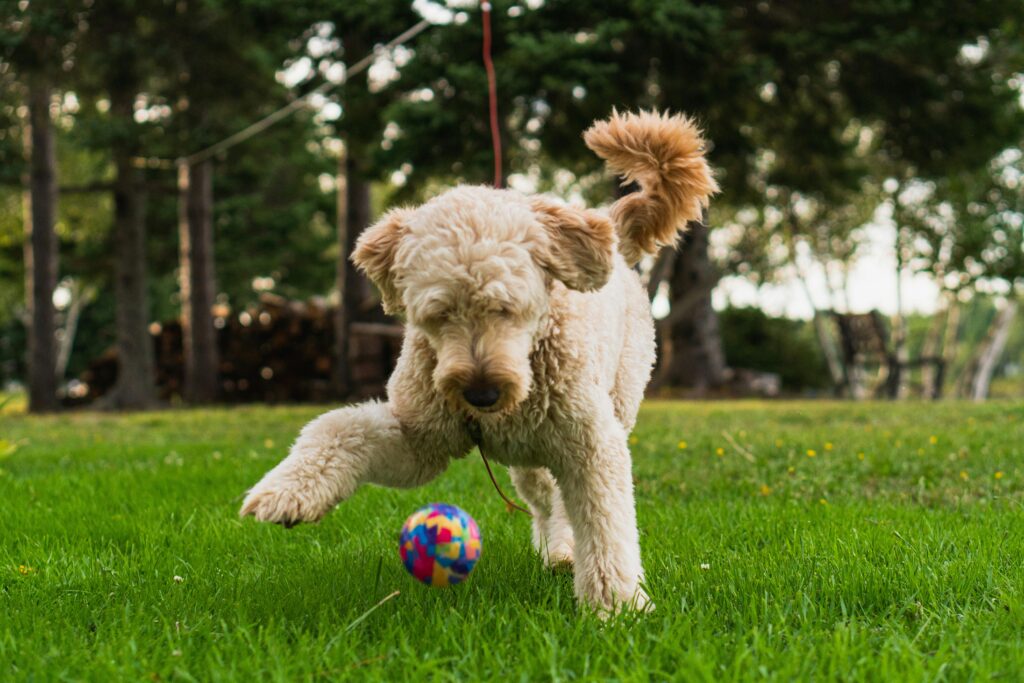Introduction
Ever wondered about the ideal Goldendoodle weight? Whether you’re a current owner or considering bringing one into your home, understanding their growth and size is crucial.
In this blog post, we’ll delve into the Golden Doodle Growth Chart, explore the characteristics of the F1 Goldendoodle, ponder the ideal size for these delightful companions, and answer common queries about their growth. Additionally, we’ll introduce a handy Goldendoodle Puppy Size and Weight Calculator to estimate your furry friend’s future dimensions.
Goldendoodle Weight Growth Chart
Creating a comprehensive Goldendoodle growth chart can be immensely beneficial for pet owners. It provides a visual representation of the expected size milestones throughout the different stages of a Goldendoodle’s life. Keep in mind that individual dogs may vary, and these figures are general estimates based on typical growth patterns.
Goldendoodle Growth Stages
Birth to 8 Weeks
During the first few weeks of life, Goldendoodle puppies experience rapid growth. At birth, they are usually small and delicate, weighing around 1 to 2 pounds. By the end of the eighth week, their weight may have increased to approximately 5 to 10 pounds, depending on factors such as genetics and the mother’s health.
2 to 4 Months
At two months, your Goldendoodle will still be a puppy, but you’ll notice a significant increase in size. Toy Goldendoodles may weigh between 5 to 15 pounds, miniatures between 10 to 20 pounds, mediums between 15 to 30 pounds, and standards between 30 to 45 pounds. Regular veterinary check-ups are crucial during this stage to monitor their overall health and development.
4 to 6 Months
Between four to six months, your Goldendoodle will continue to grow at a steady pace. Toy Goldendoodles might weigh between 10 to 20 pounds, miniatures between 20 to 35 pounds, mediums between 30 to 45 pounds, and standards between 45 to 60 pounds. This is a crucial time for training and socialization.
6 to 12 Months
As your Goldendoodle approaches its first birthday, you’ll see a gradual slowing down of growth. Toy Goldendoodles could weigh between 15 to 25 pounds, miniatures between 30 to 45 pounds, mediums between 45 to 60 pounds, and standards between 60 to 75 pounds. Regular exercise and a balanced diet are essential during this stage to support their developing bones and muscles.
1 to 2 Years
Beyond the first year, growth becomes less noticeable, and your Goldendoodle will be closer to its adult size. Toy Goldendoodles may weigh between 20 to 30 pounds, miniatures between 40 to 55 pounds, mediums between 55 to 70 pounds, and standards between 70 to 90 pounds. Nutritional needs may shift, and it’s crucial to adjust their diet accordingly.
Adult Size
By the age of two, your Goldendoodle will likely have reached its full adult size. Toy Goldendoodles generally weigh 20 pounds or less, miniatures between 25 to 45 pounds, mediums between 45 to 70 pounds, and standards between 70 to 90 pounds. Regular veterinary check-ups, a balanced diet, and appropriate exercise are essential for maintaining their health and well-being.

Factors Influencing Growth
Genetics
Genetics play a crucial role in determining the final size of your Goldendoodle. If both parents are standard-sized, it’s more likely that the offspring will also be standard-sized. Similarly, if one parent is smaller, it may influence the size of the puppies.
Nutrition
A balanced and nutritious diet is vital for healthy growth. Puppies, in particular, require diets rich in essential nutrients to support their rapid development. Consult with your veterinarian to ensure your Goldendoodle is receiving the appropriate nutrition for its size and age.
Exercise
Regular exercise is essential for the overall health and well-being of your Goldendoodle. Adequate physical activity helps develop strong muscles and bones. Tailor exercise routines based on the size and energy level of your Goldendoodle.
Creating and understanding a Goldendoodle growth chart is a valuable tool for pet owners. It allows you to monitor your furry friend’s development, ensuring they reach their full potential in a healthy and balanced manner. Remember that individual dogs may deviate from these general estimates, and consulting with your veterinarian is crucial for personalized advice. If you have any questions or would like to share your experiences with your Goldendoodle’s growth, feel free to leave a comment below.
Goldendoodle Growth Chart: A Comprehensive Guide to Your Pup’s Development
Embarking on the journey of raising a Goldendoodle comes with the excitement of watching your furry friend grow and thrive. Understanding their growth stages is essential for providing optimal care. In this guide, we’ll unravel the mysteries of the Goldendoodle Growth Chart, offering insights into the various phases and factors influencing their development.
The Puppy Stage
The Early Weeks: 0-8 Weeks
Physical Development
During the first few weeks of life, Goldendoodle puppies are entirely dependent on their mother for nourishment. They are born blind, deaf, and toothless, relying on their sense of touch and smell to navigate the world. Puppies begin to open their eyes and ears around two weeks of age, and by the end of the eighth week, they are ready to leave their mother and join their new families.
Socialization
Socialization is crucial during this early stage. Puppies should be exposed to various sights, sounds, and experiences to help them become well-adjusted adults. Gentle handling, positive interactions with humans and other animals, and exposure to different environments contribute to their social development.
Veterinary Care
Regular veterinary check-ups are essential during the puppy stage. Vaccinations, deworming, and a general health assessment ensure your Goldendoodle starts life on a healthy trajectory. Discuss a vaccination schedule and preventative care with your veterinarian to address specific needs based on your puppy’s health and environment.
The Playful Months: 2-6 Months
Teething
Teething is a natural part of the puppy stage, typically occurring between three to six months. Provide appropriate chew toys to alleviate discomfort and prevent destructive chewing. Monitor your puppy closely, and consult with your veterinarian if you notice excessive drooling, bleeding, or signs of distress during teething.
Basic Training
Basic obedience training should begin during the puppy months. Focus on commands like sit, stay, and come. Positive reinforcement, using treats and praise, is an effective way to encourage good behavior. Consistency and patience are key as your Goldendoodle puppy learns the basics of obedience.
House Training
House training is a significant milestone during the puppy stage. Establish a consistent routine for feeding, bathroom breaks, and playtime. Supervise your puppy indoors, reward successful outdoor bathroom trips, and clean accidents promptly with an enzymatic cleaner to discourage repeat incidents.
Adolescence and Teenage Months
The adolescence and teenage months of a Goldendoodle can be a challenging yet fascinating period of development. Like human teenagers, Goldendoodles undergo physical and behavioral changes that shape their adult personalities. In this guide, we’ll delve into the unique aspects of the adolescent and teenage months in Goldendoodles and offer insights into how to navigate this transitional phase.
Physical Changes
Growth Spurts
During adolescence, Goldendoodles experience significant growth spurts. Depending on their size category (toy, miniature, medium, or standard), the growth rate and duration can vary. It’s essential to monitor their weight and adjust their diet accordingly to support healthy development. Regular veterinary check-ups can help ensure that your Goldendoodle is on track with its growth milestones.
Coat Changes
Goldendoodles have a distinctive coat that can undergo changes during adolescence. The adult coat may replace the puppy coat, and the texture and color might shift. Brushing and grooming become crucial during this period to manage shedding, prevent matting, and maintain a healthy coat. Consult with a professional groomer or your veterinarian for guidance on coat care.
Behavioral Changes
Independence and Testing Boundaries
Similar to human teenagers, Goldendoodles in their teenage months may exhibit more independence and test boundaries. They may become less reliant on constant attention and more interested in exploring their surroundings. Providing a balance between freedom and guidance is essential during this stage to foster a sense of security and reinforce positive behavior.
Continued Training
Consistent training remains crucial during adolescence. While your Goldendoodle may have learned basic commands during the puppy stage, adolescence is an opportunity to refine and reinforce those skills. Positive reinforcement, rewards, and patience are key elements in managing and guiding their behavior. Consider advanced training classes to address specific challenges and enhance their overall obedience.
Socialization
Socialization is an ongoing process and the teenage months present opportunities for your Goldendoodle to interact with a variety of people, animals, and environments. Exposure to different stimuli helps build confidence and reduces the likelihood of fear or anxiety in new situations. Continue to facilitate positive social experiences to nurture a well-rounded and adaptable adult dog.
Nutritional Needs
Transition to Adult Diet
As your Goldendoodle transitions from adolescence to adulthood, their nutritional needs may change. Consult with your veterinarian to determine the most appropriate adult diet based on their size, activity level, and overall health. Adjusting portion sizes and choosing high-quality food is essential for maintaining optimal weight and well-being.
Monitoring Weight
Teenage months can be a critical period for weight management. While growth spurts are normal, excessive weight gain can impact your Goldendoodle’s health. Regularly monitor their weight, adjust their diet as needed, and engage in regular exercise to support overall fitness.
Adulting: When Do Goldendoodles Stop Growing?
Entering adulthood is a significant milestone for Goldendoodles. It marks the completion of their growth phase and the establishment of their adult size, temperament, and overall characteristics. In this guide, we’ll explore various aspects of Goldendoodle adulthood, including their physical and behavioral traits, health considerations, and tips for ensuring a happy and healthy adult life for your furry companion.
Physical Characteristics
Size and Weight
When a Goldendoodle reaches adulthood, its size and weight are relatively stable. Toy and miniature Goldendoodles typically range from 10 to 35 pounds, while medium-sized ones can weigh between 30 to 45 pounds. Standard-sized Goldendoodles may reach 45 to 90 pounds or more. These weight ranges can vary based on factors such as genetics, gender, and individual variations.
Coat
The Goldendoodle’s coat also matures during adulthood. Regular grooming is essential to manage their thick, wavy, or curly fur. Brushing helps prevent matting, removes loose hair, and maintains a healthy coat. Depending on the coat type, Goldendoodles may need professional grooming every 6 to 12 weeks.
Behavioral Traits
Temperament
The temperament developed during the puppy and adolescent stages carries into adulthood. Goldendoodles are known for their friendly, social, and intelligent nature. They are often great companions for families, as they tend to get along well with children and other pets. Positive socialization experiences during their early years contribute to a well-adjusted adult temperament.
Energy Levels
While Goldendoodles are typically energetic dogs, their activity levels may shift slightly in adulthood. Regular exercise remains essential to keep them mentally and physically stimulated. Adjust the intensity and duration of activities based on your Goldendoodle’s size, breed characteristics, and individual preferences.
Training
Adult Goldendoodles benefit from ongoing training to reinforce good behavior and address any specific challenges. Positive reinforcement techniques, using treats, praise, and consistency, continue to be effective. Engage in mental stimulation activities, such as puzzle toys and interactive games, to keep their minds active.
Health Considerations
Regular Veterinary Check-ups
Regular veterinary check-ups are crucial throughout adulthood. Annual or bi-annual visits allow the veterinarian to monitor overall health, administer vaccinations, and address any emerging health concerns. Regular dental check-ups are also important to maintain oral health.
Nutrition
Choosing the right diet is essential for maintaining your Goldendoodle’s health in adulthood. Consider factors such as size, age, and activity level when selecting their food. Obesity can be a concern, so monitor their weight and adjust their diet as needed to prevent excessive weight gain.
Tips for a Happy and Healthy Adult Life
Exercise
Regular exercise is key to a happy and healthy adult Goldendoodle. Engage in activities such as daily walks, playtime, and interactive games to keep them physically and mentally stimulated. Tailor the exercise routine to their individual needs and preferences.
Mental Stimulation
In addition to physical exercise, adult Goldendoodles benefit from mental stimulation. Provide puzzle toys, interactive feeders, and opportunities for learning new commands to keep their minds sharp and engaged.
Socialization
Continue to expose your Goldendoodle to various people, animals, and environments. Positive socialization experiences contribute to their confidence and adaptability in different situations. Goldendoodle adulthood is a rewarding phase in your canine companion’s life. With the right care, attention, and a focus on their individual needs, you can ensure a happy and healthy adulthood for your furry friend. If you have any questions or would like to share your experiences with your adult Goldendoodle, feel free to leave a comment below.

Estimating Size: How Big Will My Goldendoodle Get?
Predicting Adult Dimensions
The size of your Goldendoodle depends on factors like genetics, breed mix, and individual growth, but they typically range from 10 to 90 pounds, varying from toy to standard sizes.
Understanding the potential size of your Goldendoodle is crucial for planning their living space and lifestyle. We’ll provide insights into estimating their adult size, considering factors like genetics, nutrition, and breed generation.
The Role of Genetics and Generations
F1, F1B, F2, and Beyond
To truly understand your Goldendoodle’s growth, we’ll touch on the influence of genetics and different generations. Whether F1, F1B, or F2, each generation brings unique traits and characteristics that play a role in their overall development. Navigating the Goldendoodle Growth Chart is a rewarding experience that deepens the bond between you and your canine companion. Whether you’re anticipating the arrival of a new pup or already enjoying the company of an adult Goldendoodle, understanding their growth journey enhances the joy of pet ownership. If you have questions or insights to share, we invite you to leave a comment below. Happy growing, both for your Goldendoodle and the memories you create together!
Tailoring Size to Lifestyle
Finding the right size for your Goldendoodle involves considering your living space, activity level, and personal preferences. Whether you’re in a cozy apartment or a spacious house, we’ll guide you in determining the optimal size for a harmonious coexistence.
What Age Do Goldendoodles Stop Growing?
The Growth Plateau
Goldendoodles, like all dogs, go through growth spurts that eventually taper off. We’ll discuss the age at which your Goldendoodle is likely to stop growing and what changes you can expect during this period. Knowing when to expect maturity aids in providing proper care. Goldendoodles generally stop growing between 18 to 24 months of age. During the first year, they undergo significant growth, and the pace gradually slows down as they enter adolescence.
By the age of two, most Goldendoodles have reached their full adult size. However, individual dogs may have slight variations in their growth timeline, and factors like genetics, gender, and size category (toy, miniature, medium, or standard) can influence when they stop growing. Regular veterinary check-ups and a balanced diet contribute to their healthy development and reaching their adult size.
How Big Will My Goldendoodle Get?
Estimating Adult Size
Anticipating the final size of your Goldendoodle is a common concern for dog owners. We’ll explore factors that influence their adult size, including genetics and the specific generation of the Goldendoodle. Gain insights into predicting how big your furry friend will be.
To find out more about the Goldendoodle size, check out this blog post: The Goldendoodle Size: Discover 5 Facts Surprising about the Goldendoodle Size
Conclusion
As we wrap up this journey through the world of Goldendoodle weight, we invite you to share your thoughts and experiences. Have you found our Puppy Weight Calculator helpful? What challenges or joys have you encountered in the growth journey of your Goldendoodle? Leave a comment below and let’s continue the conversation.
Embark on this adventure of discovery with your Goldendoodle, and may every wag of their tail bring joy to your hearts!




